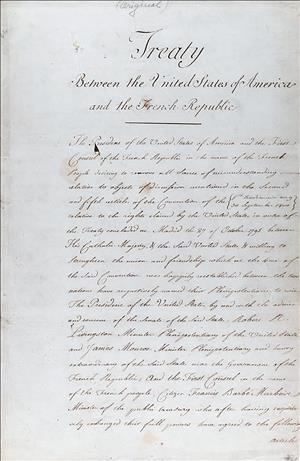On May 2, 1803, the United States and France sign the Louisiana Purchase Treaty, (which was antedated to April 30, 1803). With the stroke of a pen, the United States, a new and rather small nation, doubles in size, adding nearly 828,000 square miles -- an enormous swath of land that stretches across the entire central portion of present-day United States. France sells the land "for a song" -- about four cents an acre. The Louisiana Purchase is the achievement of America's third president, Thomas Jefferson (1743-1826). Jefferson had already planned the Lewis and Clark Expedition to explore the vast, unknown land west of the Missouri River, much of which had belonged to France. By the time the Louisiana Purchase is announced to the tiny nation on July 3, 1803, Meriwether Lewis (1774-1809) is already on his way to Pittsburgh to obtain supplies for the historic journey, which will now proceed across lands belonging to the United States.
Louisiana: Between Spain and France
Louisiana was inhabited by Indians for at least 6,000 years before Spanish explorers became the first Europeans to enter the region. In 1682 the French explorer Sierra de la Salle reached the mouth of the Mississippi River and claimed its entire drainage area for France, naming it Louisiana to honor the French king, Louis XIV. The second French governor of Louisiana, Sieur de Bienville, founded the port town of New Orleans in 1718.
New Orleans is situated on what was then a deep bayou near the Mississippi River, about 100 miles from the mouth of the river. The Mississippi flows into the Gulf of Mexico on the other side of which lies Florida, and farther south, present-day Cuba, Jamaica, the Virgin Islands, and Hispaniola (shared by the Dominican Republic and Haiti). These islands (technically the Antilles) are known as the West Indies. As a French colonial town, New Orleans became an important port, with schooners arriving from the West Indies to trade coffee and sugar. Soon after its founding, African slaves arrived. From the earliest days, the town's unique cultural mix included Native American, African, French, Spanish, and Caribbean.
In 1792 France ceded the area west of the river to Spain, but in 1800 Napoleon Bonaparte, emperor of France, made a deal with Spain to return the area to France. Napoleon wanted the thriving port of New Orleans as a base to supply French colonies in the West Indies.
American Interests
The pending transfer of New Orleans from Spain to France concerned the United States greatly because Spain, in the 1795 Treaty of San Lorenzo, had granted the U.S. the right to ship goods down to the mouth of the Mississippi without paying duty, and also the "right of deposit" -- to store goods at the bourgeoning port of New Orleans for shipment elsewhere. American settlers were pushing west, settling on the Mississippi, and floating cargo such as cotton on rafts and flatboats down the river to New Orleans.
Jefferson instructed the U.S. minister at Paris to try to stop the transaction between France and Spain, or to try to buy New Orleans. The minister tried, but he got nowhere.
Then in 1803, France's situation changed. A rebellion of free blacks and slaves had been in progress for about 12 years in the French colony of Saint-Domingue (later renamed Haiti), in the West Indies. In 1803 the rebellion succeeded in throwing off French rule and France had to withdraw from Haiti. Besides, war with Britain was imminent. These factors plus financial stringency probably prompted Napoleon to sell not only New Orleans but the entire Louisiana Territory to the United States.
American Expansion
Now Lewis and Clark could set out across land that, although inhabited by Indians and entirely unknown to anyone else, belonged not to France but to the United States. Two years later, Lewis and Clark arrived in the Pacific Northwest, entering the future Washington state on October 10, 1805. At this time the Northwest was not part of the United States. Explorers representing Spain, Great Britain, Russia (farther north), and the United States had claimed, named, and renamed it. For the next few years fur traders and especially the British Hudson's Bay Company predominated, while more and more American settlers continued to arrive. In October 1818, Great Britain and the United States signed the Treaty of Joint Occupation.
Meanwhile, following the Louisiana Purchase, American traders increasingly flocked to the Mississippi River, floating cargo and passengers to the now-American New Orleans by raft, flatboat, and ark. Items of trade included sugar, cotton, and slaves. These merchants were, like Lewis and Clark, "advance guards of American political and economic expansion" (Britannica).

